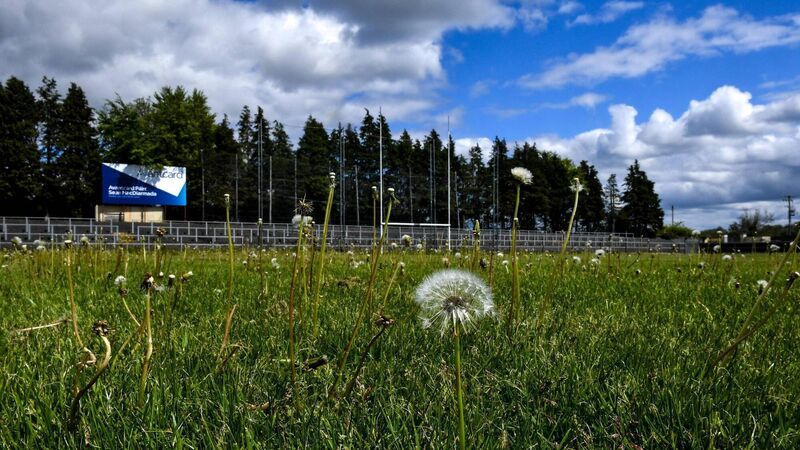Michael Moynihan: Open the stadia - without the games

The playing surface at Páirc Seán Mac Diarmada from the book 'A Season of Sundays'. While the resumption of games isn't possible at the moment, Michael Moynihan argues that the stadia should be open to the public to sample the atmosphere. Picture: Piaras Ó Mídheach/Sportsfile.
On your columnist’s daily stroll he passes Páirc Uí Rinn.
The stadium looks a little forlorn these days, though that may be down to the bad weather of recent weeks.
Few of us look our best first thing on a rainy morning.
Yet through the heavy gates you can see the flash of green. Lurking behind the stands and the terraces the pitch remains in place, even if it’s not being used.
You’d be forgiven for thinking that all over the country stadium surfaces are popping out of existence like the village of Brigadoon, ready to reappear out of the fog when restrictions are lifted again. But all of them are still there.
A sports stadium is a strange place. For most readers the associations with the local stadium are naturally fixed on games, or on training sessions and after-match post mortems, cup presentations and conversations at half-time when anticipation hangs like a cloud of cigarette smoke over the crowd. Noise and light. Talk and reaction.
A stadium’s embrace of events, of all the twists and turns in a couple of hours’ narrative, is a remarkable achievement for a building, when you think of it. Will Self said years ago that the miracle of flight should be celebrated at airports by robed priests chanting ‘fly, fly’ at the airplanes: maybe we should celebrate sports events and stadia the same way.
Because most stadia are rarely full and, in real terms, seldom used. There’s a lot of talk this week about Barcelona’s financial problems, and how many of those are related to the disappearance of paying customers - the regular 100,000 paying customers in its famed stadium.
Yet the Camp Nou isn’t even full once a week. Some stadia are full and may not be used for months on end.
In business terms this is known as (not) sweating the asset, but if the pandemic has taught us anything it’s that sport and business are not always natural bedfellows.
The intersection of sport and commerce isn’t the only clash inherent in the stadium business.
By definition, the stadium is in a town or city, yet it’s a little slice of countryside carved out of an urban landscape: the concrete and tarmac all around it give way to a bright green glimpse of nature, made all the brighter in contrast to its surroundings.
In its way, the stadium fleshes out the contradictions of field sports: though the need for grass suggests some pastoral idyll, organised team sport is the quintessential urban creation. Those are created and codified not at the gate to a field or a lonely crossroads, but in colleges and committee rooms. In towns and cities.
And hotels. It’s no accident that hotels in particular figure largely in the creation of sports from Gaelic games to rugby league. In those two examples, Hayes’ Hotel in Thurles and the George Hotel in Huddersfield are linked indelibly with the foundation of those sports, but the growth of spectator sports in the late nineteenth and early 20th centuries was also facilitated by the new ease of travel on the railways: both Thurles and Huddersfield were and are key rail centres.
It’s also interesting that the technology which enabled people to leave far-flung, disconnected rural areas for urban centres also helped standardise the disparate pursuits they enjoyed in those areas - and that a recreated meadow effect in those urban centres was so central to those pursuits.
All very well, you say, but what has that do with the price of turnips? I was going to suggest that once restrictions are eased, could people be allowed in to sports grounds just to stroll around and soak it in? Not for games as such, but just to breathe in the atmosphere?
I know people may scoff, but a walk around the terrace or stand, just taking in the light green glow of the grass . . . In Japan forest bathing, shinrin-yoku, is very popular. People walk around a forest and relax, allowing their senses to take in the forest experience
Could you do that here with a stadium? I think so. You’ve already built it. They’ll come alright.
I mentioned Barcelona FC above, a soccer club that a lot of people think fondly of — perhaps because the city itself was so accessible to us in Ireland. Getting a flight was convenient and a lot of us got to know the Barri Gòtic pretty well.
Because Barcelona itself is so attractive a location, it somehow underlines the surprise when reading about the mess the club is in. Some staggering figures were thrown around in a terrific piece earlier this week by Tariq Panja and Rory Smith. As one quick example, the way Barça officials were outflanked on Ousmane Dembélé by Borussia Dortmund was astounding.
The Spanish officials decided they’d pay no more than €80m for Dembélé before the crucial meeting, but once their meeting began the Dortmund officials said they had to catch a flight: They wanted €160m, end of story.
Barcelona needed a marquee signing, so they agreed to pay: an initial €105m plus €42m in bonuses.
Some negotiating skills.
(In fairness, it’s funny how unflattering most of the yarns you hear about contract negotiations are.) Més que un club — more than a club — was the club’s motto in Catalan. Looks like they might need to update it.
More than an ATM?
Many thanks to all who got in touch with me about the tracksuit-pants issue I flagged here last week.
Most of the suggestions were constructive. Only a few were physically impossible.
It did strike me, though, that your taste in sports leisure wear is now a reliable indicator of your age — or when you became sports-aware, to be more precise.
There was a time you could do this with the soccer teams people followed — when I was in primary school in the last century, for instance, older lads indicated their sophistication by buying single cigarettes in the shop at the front gate of the school. And by following Leeds. (There’s a joke here about damaging pastimes which I can’t be bothered to make.)
At that time — it was the 70s — Adidas were the pre-eminent brand in our little world. Is that why so many 50-somethings still rock a pair of Roms?
A couple of people were in touch asking about the book I mentioned here last week, Terry Pluto’s . It’s an oral history of the short-lived American Basketball Association, a professional league that flared briefly in the ‘70s before amalgamating with the NBA.
It’s one of the funniest sports book ever written — and one of the best — with characters like Dr J (Julius Erving), John Brisker, the league’s most feared player (who disappeared in Uganda, with some teammates believing he died as a mercenary), the executive detailing the Miami cheerleaders (“We’re talking about a brief-bikini situation”), and the player who refused a signing bonus of $1,500 because he wanted $1,000...
Recommended.








